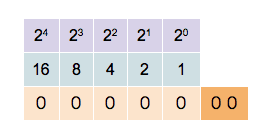Homeschool Technology Lesson 4 and 5 – More Binary and More
The second week of homeschool went very well. My eldest son wrote in his journal that despite “getting Mr. C.” he’s enjoying it. Homeschool technology lessons continued with binary practice.
Homeschool Technology
We practice more from previous lessons of adding, counting, etc. in binary. Mostly I wanted to drill home a few concepts…
- we know how high the first column goes from subtracting one from the base (e.g., base-10 -> the first column goes 0-9 then you add a column, for base-2 -> the first column goes from 0-1 and then you add a column, etc.)
- the above applies to whatever base numbering system you’re using (e.g., base-5, base-8, base-16, etc.)
- 10 is ten in decimal, but two in binary
So we practiced that over and over in lessons 4 and 5. I want to get this solid before moving on.
In lesson 5 we re-introduced hexadecimal. We know from hex (6) and decimal (10) that it’s base-16. We know the first column goes from zero to fifteen because 16-1=15. However, how do you write fifteen in one column? A: Letters.
In hexadecimal, you write A for ten, B for eleven, C for twelve, D for thirteen, E for fourteen and F for fifteen. So the first column goes from 0-F.
Then I wrote numbers on the board like “10” and asked what it’s value is. The lightbulb moment was when my question was followed by “In what?” (meaning decimal, binary or hexadecimal.
I asked for each and the answers were “ten, two and sixteen.” Yay! End of lesson!
Coming soon: Next I’ll probably go back to talk about how computers just have switches (tons of tiny switches) and that’s how they store numbers which represent values/letters/etc. which add up to files, videos, music, etc.
That may lead to a discussion about also sending data (internet) and such. But soon I’ll probably talk about files and such. Maybe I’ll use the iPad to create some simple files, then do the same on the computer but use different things to view it: text editor, browser, email it, etc. All just views of the data stored in memory as 0’s and 1’s.
